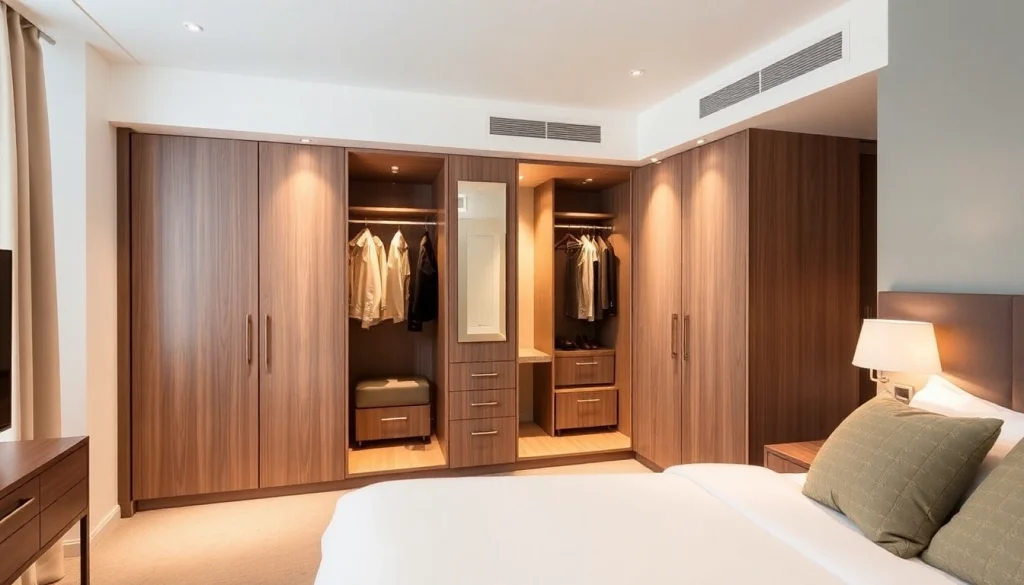Understanding Hotel Room Wardrobes
When designing hotels, every detail matters in creating a memorable guest experience. One of the key elements that often gets overlooked is the Hotel Room Wardrobes. These functional yet stylish furniture pieces play a crucial role in maximizing space, enhancing aesthetics, and ensuring guest satisfaction. In this comprehensive guide, we will explore the purpose and importance of hotel room wardrobes, delve into different types available, and discuss current trends in hotel wardrobe design.
Purpose and Importance of Hotel Room Wardrobes
The primary purpose of a hotel room wardrobe is to provide storage for guests’ belongings during their stay, which can range from a few items to an entire luggage set. A well-designed wardrobe not only helps in organizing clothes and accessories but also contributes significantly to the overall guest experience. Here are some key reasons why hotel room wardrobes are vital:
- Convenience: Easy access to clothing and personal items ensures that guests have a hassle-free stay. A spacious wardrobe allows guests to unpack and feel at home quickly.
- Organization: Adequate storage minimizes clutter, allowing guests to keep their rooms tidy. This is essential for business travelers who may require a neat space to work or relax.
- Aesthetic Appeal: The wardrobe’s design complements the overall room decor, enhancing its visual appeal. Good aesthetics contribute to guest satisfaction and potentially lead to repeat bookings.
Different Types of Hotel Room Wardrobes
When it comes to hotel room wardrobes, there is a variety of options tailored to meet different needs and preferences. Understanding these different types can help hotel managers make informed decisions:
- Freestanding Wardrobes: These standalone units are versatile and can be placed anywhere in the room. They often come in varying sizes, allowing hotels to select dimensions that suit their spaces.
- Built-in Wardrobes: Custom-designed to fit specific spaces, these wardrobes are constructed into the room’s architecture. They offer a clean look and efficient use of space but require careful planning during the design phase.
- Modular Wardrobes: Comprising individual components, modular wardrobes allow flexibility. Hoteliers can configure them to fit the room layout, which is beneficial for varied guest needs.
- Wardrobes with Luggage Racks: These designs incorporate space for luggage, ensuring that guests can easily pack and unpack. They are particularly useful in higher-end hotels where guests might have multiple bags.
Trends in Hotel Wardrobe Design
Staying ahead of trends not only enhances the guest experience but also differentiates a hotel from its competitors. Here are some of the latest design trends in hotel wardrobes:
- Minimalist Designs: Simple and sleek designs are on the rise. Minimalism focuses on functionality without sacrificing aesthetics, aligning with modern guests’ preferences for uncluttered spaces.
- Smart Technology: Some hotel wardrobes now incorporate technology like built-in charging stations or smart mirrors, enhancing the convenience and experience for tech-savvy guests.
- Eco-Friendly Materials: Sustainable materials are becoming more prevalent. Not only do they appeal to environmentally conscious consumers, but they also contribute to the hotel’s green initiatives.
Choosing the Right Hotel Room Wardrobe
Selecting the appropriate wardrobe for hotel rooms involves careful consideration of various factors. It is essential to ensure that the choice aligns with the hotel’s brand, target audience, and overall design theme. Here’s what to consider:
Factors to Consider in Wardrobe Selection
Picking the right wardrobe encompasses several factors:
- Space Availability: Analyze the room dimensions to decide on the wardrobe size. Smaller rooms might benefit from compact wardrobes or those that blend into the decor.
- Target Demographic: Understand who your primary guests are. Business travelers might prioritize functionality, while leisure travelers might value aesthetics more.
- Durability: Quality materials ensure longevity. Wardrobes should stand up to frequent use while maintaining their aesthetic appeal over time.
Customization Options for Unique Designs
Customization is a crucial aspect of wardrobe selection. It helps hotels create unique experiences tailored to their brand identity. Some customization options include:
- Color & Finish: Choose colors that complement wall colors and overall room design, whether it’s a sleek modern finish or a more rustic wood tone.
- Interiors: Customize the inside layout, including shelves, drawers, and hanging space to suit guest needs. Some guests might require more shelf space, while others need ample hanging space for suits and dresses.
- Branding Elements: Including logos or brand colors can create a cohesive look across the hotel, enhancing brand identity.
Balancing Aesthetics with Functionality
Finding the right balance between aesthetics and functionality is critical. A beautiful wardrobe that doesn’t serve its purpose will not be appreciated by guests. To ensure a balanced approach:
- Focus on User Experience: Ensure that wardrobes are user-friendly. Features like easy-to-open doors and well-placed hooks add to the overall function.
- Design Consistency: Align wardrobe design with the room style to maintain an elegant overall interior.
- Feedback Loop: Regularly seek guest feedback regarding wardrobe design and functionality to continuously improve.
Benefits of High-Quality Hotel Room Wardrobes
The value of investing in high-quality wardrobes extends beyond immediate cosmetic improvements. Several lasting benefits include:
Enhancing Guest Satisfaction and Comfort
High-quality wardrobes significantly enhance the guest experience:
- Personalized Comfort: More storage options allow guests to feel at home. Unpacking their belongings leads to a more comfortable stay.
- Aesthetic Comfort: Attractive designs contribute to guests’ overall happiness with their stay, making them more likely to leave positive reviews.
Boosting Hotel Aesthetics and Branding
Wardrobes contribute to the hotel’s visual identity. Stylish, cohesive designs support branding initiatives and create an appealing atmosphere.
Durability and Maintenance Considerations
Investing in high-quality materials means reduced maintenance costs in the long run. Durable wardrobes withstand wear and tear, retaining their appearance much longer compared to lower-quality alternatives.
Installation and Planning Tips for Hotel Wardrobes
The installation process for hotel wardrobes requires strategic planning to maximize room functionality and aesthetics. Here are important considerations and tips:
Space Management in Guest Rooms
Effective space management ensures that each room feels expansive and comfortable:
- Optimal Placement: Position wardrobes thoughtfully to avoid blocking windows or creating workflow issues, ensuring guests can move around easily.
- Multi-Functional Spaces: Use wardrobes that can also serve as dividers or supports for other functions, such as workspace or a seating area when appropriate.
Collaboration with Furniture Designers
Partnering with experienced furniture designers can yield better results:
- Expert Insights: Designers can provide valuable insights into current trends and practical layouts, ensuring that the final product aligns with hotel branding and functionality.
- Prototyping: Creating prototypes before full-scale production allows for adjustments and improvements based on feedback.
Utilizing Wardrobes for Maximum Value
Maximize wardrobe utility through smart design choices:
- Invest in Quality Fixtures: Hinges, knobs, and sliding doors should support frequent use and add user-friendly functionality.
- Versatile Add-Ons: Consider adding features such as a mirror or extra shelves, increasing the wardrobe’s functionality.
Current Trends and Innovations in Hotel Wardrobes
The hospitality industry is in constant evolution, especially in design. Staying ahead of trends ensures that hotels remain relevant and appealing to guests. Here are some of the latest innovations:
Smart Technology and Integrated Solutions
With the advent of smart technology, hotel wardrobes are becoming more functional:
- Built-in Power Outlets: Integrated charging stations make it easier for guests to charge devices without needing to hunt for outlets.
- Smart Mirrors: Mirrors that double as smart displays provide guests with real-time information, enhancing the luxury experience.
Sustainable and Eco-Friendly Materials
As green design practices become more critical, the demand for sustainable materials grows:
- Bamboo and Reclaimed Wood: Utilizing sustainable materials not only reduces environmental impact but also appeals to eco-conscious guests.
- Low-Emission Finishes: Using low-VOC finishes and materials enhances indoor air quality for guests.
Future-Proofing Hotel Designs
To ensure longevity and adaptability, hotels should consider future trends in their designs, including:
- Adaptable Spaces: Wardrobes should be designed to adapt to changing guest demographics and preferences.
- Technology Integration: As technology evolves, ensuring that furniture can accommodate future tech developments (like larger devices) is vital.

